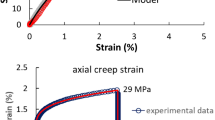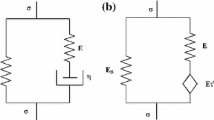Abstract
A time domain viscoelastic model for large three-dimensional responses underisothermal conditions is presented. Internal variables with fractional orderevolution equations are used to model the time dependent part of the response. By using fractional order rate laws, the characteristics of the timedependency of many polymeric materials can be described using relatively fewparameters. Moreover, here we take into account that polymeric materials are often used in applications where the small deformations approximation does nothold (e.g., suspensions, vibration isolators and rubber bushings). A numerical algorithm for the constitutive response is developed and implemented into a finite element code forstructural dynamics. The algorithm calculates the fractional derivatives by means of the Grünwald–Lubich approach.Analytical and numerical calculations of the constitutive response in the nonlinearregime are presented and compared. The dynamicstructural response of a viscoelastic bar as well as the quasi-static response of athick walled tube are computed, including both geometrically and materiallynonlinear effects. Moreover, it isshown that by applying relatively small load magnitudes, the responses ofthe linear viscoelastic model are recovered.
Similar content being viewed by others
References
Bagley, R. L. and Torvik, P. J., 'Fractional calculus – A different approach to the analysis of viscoelastically damped structures', AIAA Journal 21, 1983, 741–748.
Welch, S.W. J., Rorrer, R. A. L., and Duren Jr., R. G., 'Application of time-based fractional calculus methods to viscoelastic creep and stress relaxation of materials', Mechanics of Time-Dependent Materials 3, 1999, 279–303.
Padovan, J., 'Computational algorithms for FE formulations involving fractional operators', Computational Mechanics 2, 1987, 271–287.
Enelund, M., Mähler, L., Runesson, K., and Josefson, B. L., 'Formulation and integration of the standard linear viscoelastic solid with fractional order rate laws', International Journal of Solids and Structures 36, 1999, 2417–2442.
Schmidt, A. and Gaul, L., 'Finite element formulation of viscoelastic constitutive equations using fractional time derivatives', Nonlinear Dynamics 29, 2002, 37–55.
Simo, J. C., 'On a fully three dimensional finite strain viscoelastic damage model: Formulation and computational aspects', Computer Methods in Applied Mechanics and Engineering 60, 1987, 153–173.
Simo, J. C. and Holzapfel, G. A., 'A new viscoelastic constitutive model for continuous media at finite thermomechanical changes', International Journal of Solids and Structures 33, 1996, 3019–3034.
Holzapfel, G. A., 'On large strain viscoelasticity: Continuum formulation and finite element applications to elastomeric structures', International Journal for Numerical Methods in Engineering 39, 1996, 3903–3926.
Simo, J. C. and Hughes, T. J. R., Computational Inelasticity, Interdisciplinary Applied Mathematics, Springer-Verlag, New York, 1989.
Lubliner, J., 'A model of rubber viscoelasticity', Mechanics Research Communications 12, 1985, 93–99.
Bonet, J., 'Large strain viscoelastic constitutive models', International Journal of Solids and Structures 38, 2001, 2953–2968.
Reese, S. and Govindjee, S., 'A presentation and comparison of two large deformation viscoelasticity models', Journal of Engineering Materials and Technology 119, 1997, 251–255.
Reese, S. and Govindjee, S., 'A theory of finite viscoelasticity and numerical aspects', International Journal of Solids and Structures 35, 1998, 3455–3482.
Enelund, M. and Olsson, P., 'Damping described by fading memory – Analysis and application to fractional derivative models', International Journal of Solids and Structures 36, 1999, 939–970.
Oldham, K. B. and Spanier, J., The Fractional Calculus, Academic Press, New York, 1974.
Enelund, M. and Lesieutre, G. A., 'Time domain modeling of damping using anelastic displacement fields and fractional calculus', International Journal of Solids and Structures 36, 1999, 4447–4472.
Lion, A., 'On the thermodynamics of fractional damping elements', Continuum Mechanics and Thermodynamics 9, 1997, 83–96.
Lubich, Ch., 'Discretized fractional calculus', SIAM Journal on Mathematical Analysis 17, 1986, 704–719.
Bathe, K. J., Finite Element Procedures, Prentice-Hall, Englewood Cliffs, NJ, 1996.
Cook, R. D., Malkus, D. S., and Plesha, M. E., Concepts and Applications of Finite Element Analysis, Wiley, New York, 1989.
Flügge, W., Viscoelasticity, Springer, New York, 1975.
Bateman, H., Higher Transcendental Functions, Vol. 3, McGraw-Hill, New York, 1955.
Enelund, M. and Josefson, B. L., 'Time-domain finite element analysis of viscoelastic structures with fractional derivatives constitutive relations', AIAA Journal 35, 1997, 1630–1637.
Author information
Authors and Affiliations
Rights and permissions
About this article
Cite this article
Adolfsson, K., Enelund, M. Fractional Derivative Viscoelasticity at Large Deformations. Nonlinear Dynamics 33, 301–321 (2003). https://doi.org/10.1023/A:1026003130033
Issue Date:
DOI: https://doi.org/10.1023/A:1026003130033




